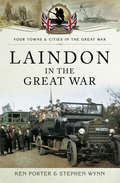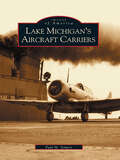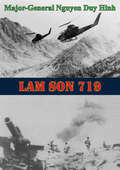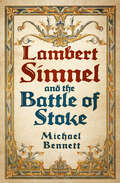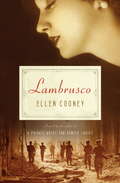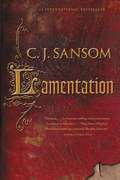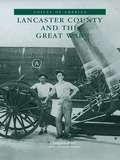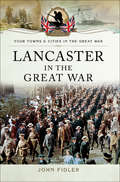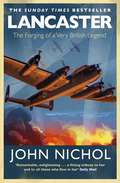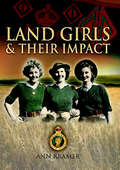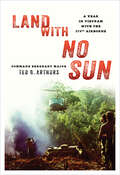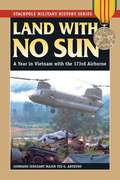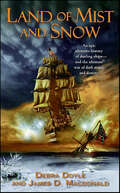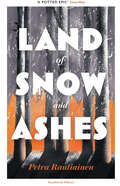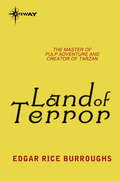- Table View
- List View
Laindon in the Great War: Laindon In The Great War (Your Towns & Cities in the Great War)
by Ken Porter Stephen WynnA brief history of how the people of Laindon and district coped with the problems of the First World War Throughout the book are individual family memories, over 100 photographs and appropriate oems mostly written at the time. Indication of why Britain went to war Insight into the role of the local Explosive factories. Individual stories of those who applied for exemption and the hysteria of suspected spies. The role played by our Women Folk Culminating in individual stories of our men folk who went to war on our behalf.
Lake Ilmen, 1942: The Wehrmacht Front to the Red Army
by Óscar González Pablo SagarraThis WWII combat history sheds light on the Battle for Staraya Russa, in which German soldiers and Spanish volunteers bitterly fought the Red Army. In January 1942, in the Staraya Russa sector south of Lake Ilmen, the 16th German Army clashed with Vasili Morozov's 11th Soviet Army for possession of the region. Fighting alongside the Germans were the Spanish volunteers of the Blue Division. Though the fighting lasted for nearly a month, the battle for Staraya Russa is all but forgotten in studies of the Second World War&’s Eastern Front. In Lake Ilmen, 1942, the authors present a strategic framework of the battle from both the German and Russian perspectives. They also recount the hard fighting and extreme weather endured by both sides, bringing the human aspect of the conflict to life through a survey of individual volunteers who fought in it.
Lake Michigan's Aircraft Carriers (Images of America)
by Paul M. SomersLake Michigan's Aircraft Carriers is the story of the USS Wolverine and the USS Sable, two Great Lakes excursion ships converted for use as aircraft carrier training during World War II. Through the duration of the war, the United States Navy qualified 17,800 pilots for aircraft carrier operation. Training the pilots on either the Atlantic or the Pacific Ocean would have exposed the training ships to the danger of submarine attack, while requiring the escort of fighting ships that were needed elsewhere. It would also have involved arming and armoring the ships used for training. Commander R.F. Whitehead came up with an idea that solved all of these problems. He suggested doing the training on the protected waters of the Great Lakes.The USS Wolverine and the USS Sable were chosen and thus became the only fresh water, paddle-wheeled, coal-fired aircraft carriers in the history of the world. Author Paul M. Somers shares his collection of vintage photos and a lifetime of research to detail the history of these two great vessels-from their life as cruise ships to their contributions to the war effort and then to their eventual scrapping.
Lakeview Protector
by Shirlee McCoyA military vet and a troubled widow are caught in a case of disappearing women in the woods in this inspirational romantic suspense mystery.Ex-military man Eli Jennings owed his commander his life and vowed to repay him by finding his missing sister. His search led to Jasmine Hart’s mountain cabin in Lakeview, Virginia, where another woman had disappeared. A strong-willed widow, Jasmine didn’t think the two were related. Until a major clue to both mysteries was found in her house. And her own mother-in-law was a witness. Scared for the only family she had left, Jasmine turned to Eli for help. But someone powerful wanted to ensure she never felt safe, never learned the whole truth. And that meant making one more woman disappear.
Lam Son 719 [Illustrated Edition]
by Major-General Nguyen Duy HinhIncludes over 30 maps and illustrationsFor several years, the eastern part of the Laotian panhandle was used by North Vietnam as a corridor for the infiltration of personnel and materiels required to sustain its war efforts in South Vietnam and Cambodia. In addition to the Ho Chi Minh Trail, the eastern panhandle contained many logistic installations and base areas. After the 18 March 1970 change of government in Cambodia which closed the port of Sihanoukville to the enemy, this trail-base area complex in lower Laos became even more important to North Vietnam in its prosecution of the war in the South. The real hub of this entire complex, where transportation and storage activities were coordinated, was Base Area 604 located west of the Demilitarized Zone and surrounding the district town of Tchepone.To disrupt the flow of enemy personnel and supplies into South Vietnam, a ground attack was launched across the Laotian border against this enemy hub of activity on 8 February 1971. Operation LAM SON 719 was conducted by I Corps with substantial U.S. support in firepower and heli-lift but without the participation of U.S. advisers with those ARVN units fighting in Laos. As a test of Vietnamization, this operation was to demonstrate also the progress achieved in combat effectiveness by the Republic of Vietnam Armed Forces. Further, LAM SON 719 achieved the objective of forestalling a Communist offensive in the spring of 1971.
Lambert Simnel and the Battle of Stoke
by Michael BennettWithin two years of the battle of Bosworth, Henry Tudor was forced to defend his throne against a formidable challenge mounted on behalf of a ten-year-old boy who had been crowned in Dublin as ‘Edward VI’. Though presented as the last surviving Plantagenet, the young lad is generally known to history as Lambert Simnel.Lambert Simnel and the Battle of Stoke unravels the tangled web of dynastic politics and rivalries in Yorkist England, seeking a context for the bizarre events of 1487. It considers the political instability and the miasma of intrigue associated with the reign of Richard III and the first years of Henry VII. It seeks to probe the mysteries surrounding Lambert Simnel, raising questions about his identity and the roots and ramifications of the movement that centred on him. Above all, it charts the progress of the conspiracy and rebellion, from the raising of troops in the Netherlands and Ireland to the ‘coronation’ in Dublin in May 1487, from the invasion of northern England through to the final, bloody encounter outside the village of East Stoke, near Newark, in June. Henry’s triumph in the field, the last occasion when an English king personally took to the field against a rival, marked an important stage in the development of Tudor polity.In this revised and updated edition, Professor Michael Bennett offers new information and insights on this remarkable episode in English history, seeks clarity and coherence in accounts of the fast-moving drama, re-examines old and new evidence, including misconceptions and misinformation, and addresses recent theories regarding the identity of the Dublin king.
Lambrusco: A Novel
by Ellen CooneyThe year is 1943. The Nazis have invaded Italy; American troops have landed. At Aldo's restaurant on the Adriatic coast, Lucia Fantini entertained customers for years with her marvelous opera singing. But normal operations are over. The restaurant has been seized by nazifascisti, and a Resistance squad of waiters and local tradesmen has been formed, led by Lucia's son, Beppino. When Beppino disappears, Lucia must journey across war-devastated Italy to find him. Aided by a richly drawn cast of characters, the story of her adventures is told with the vigor, drama, and lyrical grace of an Italian opera, in a brilliantly arranged narrative that places tragic events side-by-side with high comedy, domestic intrigues, and gripping details. In this captivating story of a mother and son, Cooney enters a world of peril and chance, and brings to life the extraordinary Resistance movement of the Italian people.
Lamentation: A Shardlake Novel (The Shardlake Series #6)
by C. J. SansomAs Henry VIII lies on his deathbed, an incendiary manuscript threatens to tear his court apart. Summer, 1546. King Henry VIII is slowly, painfully dying. His Protestant and Catholic councilors are engaged in a final and decisive power struggle; whoever wins will control the government. As heretics are hunted across London, and radical Protestants are burned at the stake, the Catholic party focuses its attack on Henry's sixth wife--and Matthew Shardlake's old mentor--Queen Catherine Parr. Shardlake, still haunted by his narrow escape from death the year before, steps into action when the beleaguered and desperate Queen summons him to Whitehall Palace to help her recover a dangerous manuscript. The Queen has authored a confessional book, Lamentation of a Sinner, so radically Protestant that if it came to the King's attention it could bring both her and her sympathizers crashing down. Although the secret book was kept hidden inside a locked chest in the Queen's private chamber, it has inexplicably vanished. Only one page has been recovered--clutched in the hand of a murdered London printer. Shardlake's investigations take him on a trail that begins among the backstreet printshops of London, but leads him and his trusty assistant Jack Barak into the dark and labyrinthine world of court politics, a world Shardlake swore never to enter again. In this crucible of power and ambition, Protestant friends can be as dangerous as Catholic enemies, and those with shifting allegiances can be the most dangerous of all.
Lamento por Darley Dene
by Cassia Pereira Stuart G. YatesBaseado em fatos reais. Após a Segunda Guerra Mundial, o garoto Ben descobre uma história sinistra. Em 1941, num bombardeio, soldados morreram exatamente onde está o terreno que costuma jogar. Com os terríveis acontecimentos do passado e o seu lento desdobramento, Ben se envolve em uma série de estranhos, inexplicáveis incidentes, com velhos segredos e verdades ocultas lentamente sendo reveladas. Esta é uma história de autodescoberta e de superação do medo, pois aquilo que está sob o solo é verdadeiramente arrepiante. Ben está prestes a descobrir os segredos de sua família e terá de ajudar a sepultar o horror do que aconteceu em Darley Dene.
Lana's War: A Novel
by Anita AbrielFrom the bestselling author of The Light After the War comes the unforgettable story of a young woman waging her own war against the Nazis as a spy for the Resistance on the French Riviera. Paris, 1943: Lana Antanova is rushing to tell her husband she is pregnant when she witnesses him being executed by a Gestapo officer for hiding a Jewish girl in a piano. Overcome with grief, Lana loses the baby. A few months later, a heartbroken Lana is approached to join the Resistance on the French Riviera. As the daughter of a Russian countess, Lana has the perfect background to infiltrate the émigré community of Russian aristocrats who socialise with Nazi officers, including the man who killed her husband. Lana&’s cover story makes her the mistress of a wealthy Swiss playboy, the darkly handsome and charismatic Guy Pascal, and her base his villa in Cap Ferrat. Together they make a ruthlessly effective team. Consumed by her mission, Lana doesn&’t count on becoming attached to a young Jewish girl or falling helplessly in love with Guy. As the Nazis close in, Lana&’s desire to protect the ones she loves threatens to put them all at risk.
Lana's War: A Novel
by Anita AbrielFrom the author of the &“fast-paced, heartbreaking, and hopeful&” (Kristin Harmel, author of The Room on Rue Amélie) The Light After the War, a riveting and heartfelt story of a young woman recruited to be a spy for the resistance on the French Riviera during World War II. Paris 1943: Lana Antanova is on her way to see her husband with the thrilling news that she is pregnant. But when she arrives at the convent where he teaches music, she&’s horrified to see Gestapo officers execute him for hiding a Jewish girl in the piano. A few months later, grieving both her husband and her lost pregnancy, Lana is shocked when she&’s approached to join the resistance on the French Riviera. As the daughter of a Russian countess, Lana has the perfect background to infiltrate the émigré community of Russian aristocrats who socialize with German officers, including the man who killed her husband. Lana&’s cover story makes her the mistress of Guy Pascal, a wealthy Swiss industrialist and fellow resistance member, in whose villa in Cap Ferrat she lives. Together, they gather information on upcoming raids and help members of the Jewish community escape. Consumed by her work, she doesn&’t expect to become attached to a young Jewish girl or wonder about the secrets held by the man whose house she shares. And as the Nazis&’ deadly efforts intensify, her intention to protect those around her may put them all at risk instead. With Anita Abriel&’s &“heartfelt and memorable&” (Pam Jenoff, New York Times bestselling author) storytelling, Lana&’s War is a sweeping and suspenseful tale of survival and second chances during some of the darkest days of history.
Lancaster County and the Great War (Voices of America)
by John Chandler GriffinThough the machines and technology have changed drastically over the past century, the themes of sacrifice, loyalty, and heroism have been felt by countless generations of American soldiers. While today's armed forces depend on the accuracy of satellites and "smartbombs," the American soldier of the early twentieth century fought under much different circumstances--an era dominated by machine guns, massive artillery, gas masks, biplanes, and trench warfare. Our nation's families, at that time, were full of patriotic pride and were more than willing to give their sons in the fight for democracy. Lancaster County, a rural community in the Palmetto State's Upcountry, was proud to count many of its men as the first volunteers in our country's call to arms. In Lancaster County and the Great War, you will listen to the compelling stories of many of the county's veterans of World War I, from their trials of admission and boot camp to the nightmarish scenes in the barbed-wire-lined, bullet-ridden trenches to the victory celebrations they experienced in foreign landscapes and back at home. Complemented with period photographs, local county newspaper headlines, and wartime posters, these personal histories truly share a unique experience in South Carolina's and our country's past. As you read through these pages, you will feel as if you have been handed a government-issue rifle, journeyed across the East Coast to various training camps, felt the incredible fear and anxiety of battle, and paraded down Lancaster's streets to the ovation of joyous crowds.
Lancaster in the Great War
by John FidlerAlthough Lancaster was the ancient County town, it had a population of only 40,000 in 1914. Of these, it is thought that some 5,000 men saw war service between 1914-18, and over 1,000 did not return. In consequence, the recruiting drives, the tribunals to consider exemption from 1916, and the ever-growing casualty lists provide the main theme for this book.Some 3,000 men had volunteered by December 1914, to join those already serving. While the depot of the Kings Own Royal Lancaster Regiment was in the town, about eighty regiments had Lancaster men in their ranks, and both the casualty lists and the awards for gallantry reflect this.The town was out of range for shelling from the sea, or aerial bombardment, but did experience an explosion at its munitions factory in 1917. Apart from this, the mayor and council endeavoured to continue with their primary duties as far as possible in running the town.
Lancaster: The Forging of a Very British Legend
by John Nichol'The epic story of an iconic aircraft and the breathtaking courage of those who flew her' Andy McNab, bestselling author of Bravo Two Zero 'Compelling, thrilling and rooted in quite extraordinary human drama' James Holland, author of Normandy 44 From John Nichol, the Sunday Times bestselling author of Spitfire, comes a passionate and profoundly moving tribute to the Lancaster bomber, its heroic crews and the men and women who kept her airborne during the country's greatest hour of need. 'The Avro Lancaster is an aviation icon; revered, romanticised, loved. Without her, and the bravery of those who flew her, the freedom we enjoy today would not exist.'Sir Arthur Harris, the controversial chief of Royal Air Force Bomber Command, described the Lancaster as his 'shining sword' and the 'greatest single factor in winning the war'. RAF bomber squadrons carried out offensive operations from the first day of the Second World War until the very last, more than five and a half years later. They flew nearly 300,000 sorties and dropped around a million tons of explosives, as well as life-saving supplies. Over 10,000 of their aircraft never returned. Of the 7,377 Lancasters built during the conflict, more than half were lost to enemy action or training accidents.The human cost was staggering. Of the 125,000 men who served in Bomber Command, over 55,000 were killed and another 8,400 were wounded. Some 10,000 survived being shot down, only to become prisoners of war. In simple, brutal terms, Harris's aircrew had only a 40 per cent chance of surviving the war unscathed.Former RAF Tornado Navigator, Gulf War veteran and bestselling author John Nichol now tells the inspiring and moving story of this legendary aircraft that took the fight deep into the heart of Nazi Germany.
Land Based Air Power or Aircraft Carriers?: A Case Study of the British Debate about Maritime Air Power in the 1960s (Corbett Centre for Maritime Policy Studies Series)
by Gjert Lage DyndalDuring the 1960s - in the midst of its retreat from empire - the British government had to grapple with complex political and military problems in order to find a strategic defence policy that was both credible and affordable. Addressing what was perhaps the most contentious issue within those debates, this book charts the arguments that raged between supporters of a land based air power strategy, and those who favoured aircraft carriers. Drawing upon a wealth of previously classified documents, the book reveals how the Admiralty and Air Ministry became interlocked in a bitter political struggle over which of their military strategies could best meet Britain's future foreign policy challenges. Whilst the broad story of this inter-service rivalry is well known - the Air Force's proposal for a series of island based airfields, and the Navy championing of a small number of expensive but mobile aircraft carriers - the complexity and previous lack of archival sources means that it has, until now, only ever been partially researched and understood. Former studies have largely focused on the cancellation of the CVA-01 carrier programme, and offered little depth as regards the Royal Air Force perspectives. Given that this was a two-Service rivalry, which greatly influenced many aspects of British foreign and defence policy decisions of the period, this book presents an important and balanced overview of the complex issues involved. Through this historical study of the British debate about maritime air power and strategic alternatives in the 1960s, the detailed arguments used for and against both alternatives demonstrate clear relevance to both historical and contemporary conceptual debates on carrier forces and land-based air power. Both from military strategy and inter-service relationship perspectives, contemporary Britain and many other nations with maritime forces may learn much from this historical case.
Land Girls
by Angela HuthWith the country's men at war, it falls to the land girls to pitch in and do their bit...Stella arrives at Hallows Farm in her Rayon stockings, having just waved goodbye to the love of life - naval officer Philip. Agatha has just graduated from Cambridge; life on the Farm is certainly going to offer her a different kind of education. Prue, a hairdresser from Manchester, is used to painting the town red, not manual labour. Joe dreams of leaving the family farm and becoming a fighter pilot. But with the arrival of these three beautiful young women, there's enough to keep him busy on the farm for the time being...Work is hard and the effects of war start to take their toll on the three women. But as the bonds of friendship start to form and excitement builds as the RAF dance looms, maybe life in the countryside isn't so bad after all?
Land Girls & Their Impact
by Ann Kramer"The impact of the land girls cannot be ignored. It was not just that women were working and farms had more women than men, women who were not part of the family or, for some of them, had even lived in the countryside before – but women were wearing trousers and filling in for men, some of whom would never return from war. For the women, their time as land girls changed their lives and how they viewed their own role in society and the family. Using original interviews and photographs from some of these land girls, historian Ann Kramer delves deeper than any previous study to understand the role of the land girls both during and after the Second World War."
Land Girls (Isis Cassettes Ser.)
by Angela HuthWith the country's men at war, it falls to the land girls to pitch in and do their bit...Stella arrives at Hallows Farm in her Rayon stockings, having just waved goodbye to the love of life - naval officer Philip. Agatha has just graduated from Cambridge; life on the Farm is certainly going to offer her a different kind of education. Prue, a hairdresser from Manchester, is used to painting the town red, not manual labour. Joe dreams of leaving the family farm and becoming a fighter pilot. But with the arrival of these three beautiful young women, there's enough to keep him busy on the farm for the time being...Work is hard and the effects of war start to take their toll on the three women. But as the bonds of friendship start to form and excitement builds as the RAF dance looms, maybe life in the countryside isn't so bad after all?
Land Girls at the Wartime Bookshop: Book 2 in the uplifting WWII saga series about a community-run bookshop, from the bestselling author (The Wartime Bookshop #2)
by Lesley EamesThe residents of Churchwood have never needed their bookshop, or its community, more. But when the bookshop comes under threat at the worst possible time, can Alice, Kate and Naomi pull together to keep spirits high?Kate has always found life on Brimbles Farm difficult, but now she is struggling more than ever to find time for the things that matter to her - particularly helping to save the village bookshop and seeing handsome pilot Leo Kinsella. Can two Land Girls help? Or will they be more trouble than they're worth?Naomi has found new friends and purpose through the bookshop and is devastated when its future is threatened. But when she begins to suspect her husband of being unfaithful, she finds her attention divided. With old insecurities rearing up, she needs to uncover the truth.Alice has a lot on her plate. Can she fight to save the bookshop while also looking for a job and worrying about her fiancé Daniel away fighting in the war?Land Girls at the Wartime Bookshop is the second novel in the uplifting Wartime Bookshop series, perfect for fans of Donna Douglas and Elaine Everest.**The fourth novel, Evacuees at the Wartime Bookshop, is available to pre-order now!**-------------------------------**Real readers are LOVING The Wartime Bookshop series**'BRILLIANT''Oh I loved this book... please carry on the good writing''Wow what a brilliant start to a new series''Outstandingly fabulous, warm and inviting... so glad there is going to be a follow-on''I was only two pages in when I knew this would be a 5 star read... I honestly can't put my excitement into words at the thought of reading the next one'
Land With No Sun: A Year in Vietnam with the 173rd Airborne
by Commander Ted G ArthursA first-person history of the action seen by the United States airborne infantry brigade in Vietnam, from a Silver Star awarded Command Sergeant Major. A no-holds-barred, straight-in-your-face account of combat in Vietnam. You know it's going to be hot when your brigade is referred to as a Fireball unit. From May 1967 through May 1968, Ted Arthurs was in the thick of it, humping an eighty-pound rucksack through triple canopy jungle, chasing down the Viet Cong and North Vietnamese in the Central Highlands of South Vietnam. As sergeant major for a battalion of eight-hundred men, it was his job to see them through this jungle hell and get them back home again.
Land With No Sun: A Year in Vietnam with the 173rd Airborne (Stackpole Military History Series)
by Ted G. ArthursA no-holds-barred, straight-in-your-face account of combat in Vietnam.
Land of Mist and Snow
by Debra Doyle James D. MacdonaldCalled to duty at last, Lieutenant John Nevis faces his assignment with trepidation. Boarding the USS Nicodemus—a sloop of war built in a single night at the top of the world—Nevis wonders uneasily at its strange aura of power, its cannonballs of virgin brass . . . and its uncanny ability to glide swiftly through the waters without steam or sail. As great armies clash all around them, the mission of Lieutenant Nevis and the Nicodemus crew is shrouded in an impenetrable gray mist of magic and malevolence. For a fearsome adversary awaits on roiling waves—an awesomely powerful vessel fueled by cruelty and terror; a demon raider driven by an insatiable lust . . . for blood.
Land of Snow and Ashes
by PETRA RAUTIAINENThe haunting, gripping story of Lapland's buried history of Nazi crimes during World War II, perfect for fans of Stolen by Ann-Helén Laestadius&“A beautifully written novel and a thriller that will keep readers turning the page to find out the truth about this disgraceful chapter of Finnish history&” – Harvard ReviewFinnish Lapland, 1944: a young soldier is called to work as an interpreter at a Nazi prison camp. Surrounded by cruelty and death, he struggles to hold onto his humanity. When peace comes, the crimes are buried beneath the snow and ice.A few years later, journalist Inkeri is assigned to investigate the rapid development of remote Western Lapland. Her real motivation is more personal: she is following a lead on her husband, who disappeared during the war. Finding a small community riven with tension and suspicious of outsiders, Inkeri slowly begins to uncover traces of disturbing facts that were never supposed to come to light.From this starkly beautiful polar landscape emerges a story of silenced histories and ongoing oppression, of human brutality and survival.
Land of Terror: Pellucidar Book 6 (PELLUCIDAR)
by Edgar Rice BurroughsIf you have ever wondered what a civilized man of the twentieth century would do if catapulted into an Old Stone Age where huge cave bears, saber-toothed tigers, monstrous carnivorous dinosaurs, mammoths, and mastodons roamed the savage terrain, you need look no further thanLand of Terror, the sixth installment of Edgar Rice Burroughs's Pellucidar series. Years ago David Innes and Abner Perry bored straight down through five hundred miles of the earth's crust and landed in Pellucidar, the savage, primeval world that lies at the center of the earth. This is the story of their continuing adventures in the timeless land of perpetual noon and their encounters with the hideous creatures and savage men who pursue them. Although they encounter enemies at every turn, David and Abner find a few loyal friends as they embark on exhilarating adventures.
Land of War: A History of European Warfare from Achilles to Putin
by William NesterWar in Europe began with the first human migrants. Rival bands fought for thousands of years before the Greeks and Romans began writing about their military history, first as legend—for instance, the hero Achilles battling the Trojans—and then as fact. War developed from sticks and stones to bronze, iron, and steel, including armor and edged weapons. Then came gunpowder, guns, and cannons, which eventually replaced edged weapons. Finally, in the nineteenth and twentieth centuries, technology exploded: railroads, steamships, telegraphs, machine guns, automobiles, airplanes, and tanks enabled European states to muster, equip, arm, transport, and command more men than ever before, with more firepower than ever before. In the past seventy-five years, atomic weapons changed the military landscape of Europe—as have the internet and cyber warfare. In this colorful new telling of European warfare—and indeed European history through the continent&’s all too numerous wars and conflicts—William Nester describes millennia of armed conflict. He covers the &“greatest hits&” of military history both ancient and current: Thermopylae, the Peloponnesian War, the wars of the Roman Empire across the continent, the Battle of Hastings, the Crusades, Agincourt, Waterloo, Napoleon and Wellington, the Somme, the Spanish Civil War, Stalingrad and Normandy, Churchill, Hitler, and Stalin, Bosnia, and up through Putin&’s attempts to redraw the map of Europe. Nester highlights how warfare has been deeply entwined with European statesmanship and undergirds modern institutions such as NATO and the European Union. Europe&’s sense of itself is bound up in its military history. Land of War is an epic odyssey from Europe&’s mythic origins through its latest violent conflicts.
